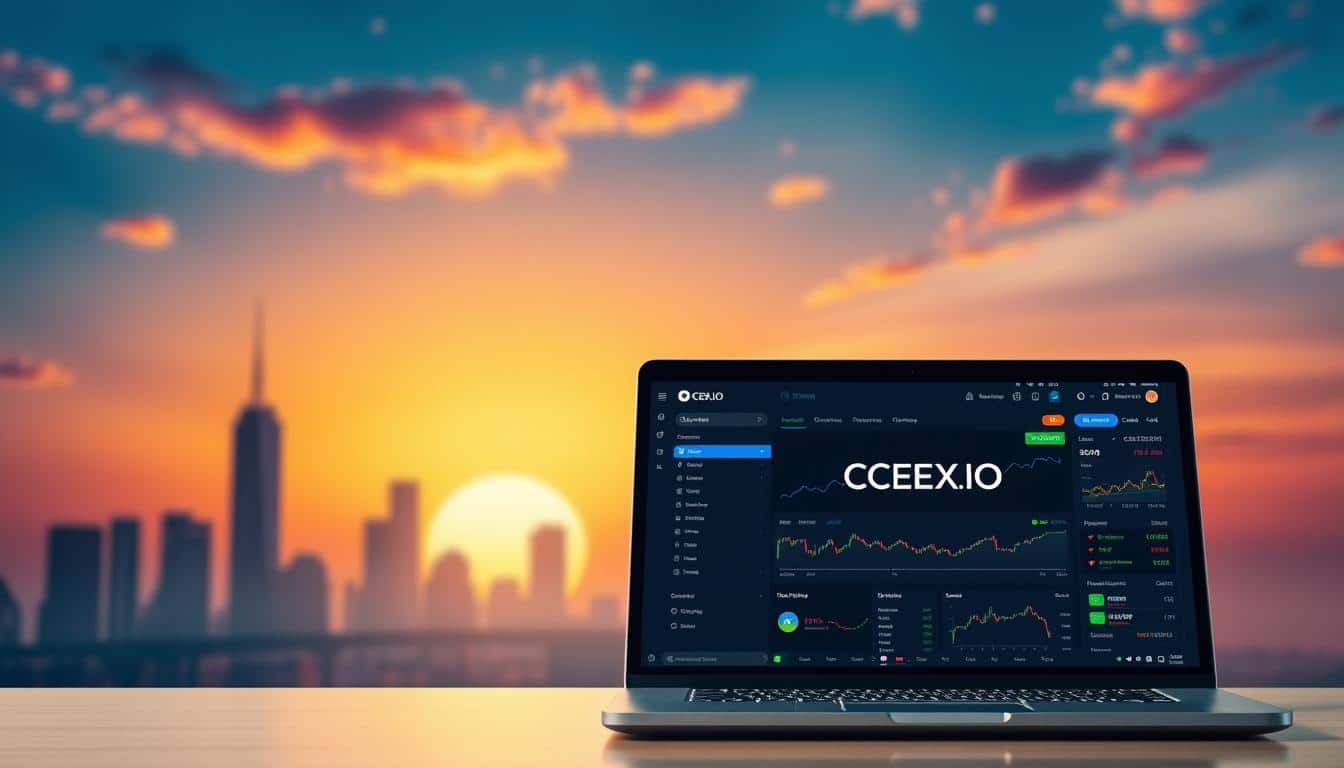Nearly 40% of U.S. retail investors might think about buying digital assets next year. This interest is a key reason why cex.io is expanding in America. As a journalist, I’ve seen this exchange grow from focusing on Europe to embracing the U.S. market. This shift is big news for those looking to invest in bitcoin or other cryptocurrencies.
News shifts markets, from Tether’s funding discussions to oil price reports. These changes affect how money moves between commodities and cryptocurrencies. It impacts trading conditions on exchanges like cex.io. I keep an eye on these trends because they influence traders’ decisions.
Key Takeaways
- CEX.IO’s U.S. expansion gives American traders more options to buy bitcoin on a familiar platform.
- Macro headlines — like Tether funding and oil inventory reports — affect liquidity and trading behavior.
- cex.io positions itself as a secure trading platform amid growing institutional and retail flows.
- U.S. availability increases competition among leading cryptocurrency exchange services.
- I recommend DIY traders watch spreads and liquidity as the platform scales in the U.S.
Overview of CEX.IO’s Expansion
I began looking at how CEX.IO, a platform from London, works with U.S. regulations. From the start, it mixed services for everyday users with tools for serious traders and big players. The clarity of fees and the speed of moving money caught my eye right away.
Background of CEX.IO
Starting in London, CEX.IO grew to serve Europe and then the world. It added trading, staking, loans, and services for buying and selling. It targeted both individual users and big investors. Thanks to this, many view CEX.IO as a top choice among crypto exchanges for different types of users.
Significance of U.S. Market
For CEX.IO, the U.S. is key because of its big market and strict rules. Offering more here means access to lots of users and big money. Big funding events often change the game for how exchanges operate. This shapes where people want to trade and which platforms they trust.
Services Offered
The U.S. expansion includes trading bitcoin and ethereum, plus more where allowed. Users can pick between secure wallets and usual payment ways for adding or taking out money. What stood out to me were the fast trades and clear fees. These factors help users decide where to trade.
User Demographics and Market Reach
In U.S. forums and comment threads after major stablecoin news, I see more questions about trading safely. This talk aligns with broader signs, like investment trends, driving people toward crypto for protection.
Current User Statistics
Exchange trends highlight growing activity among both individual and big investors. Major stablecoin transactions have led to more fiat entry points beefing up. The context hints at ongoing growth for platforms offering legal access and storage services, even though CEX.IO doesn’t share exact user numbers.
Target Audience in the U.S.
Dedicated traders rank high in demand. They seek precision and speed in crypto trading. Following closely are retail investors aiming to deal in bitcoin or ethereum. Also, tech-savvy young people and smaller pro traders look for easy and legal ways to trade, which sites like cex.io strive to provide.
Trends in U.S. Cryptocurrency Adoption
U.S. adoption grows when mainstream markets shake. This is seen in online discussions post-oil report and after big crypto cash boosts. People move money into digital currencies for safety or different gains. Hence, a crypto exchange that’s clear about U.S. access tends to draw both individuals and big investors.
| User Segment | Primary Motive | Platform Needs |
|---|---|---|
| DIY Technical Traders | Advanced execution, arbitrage | API access, low latency, charting |
| Retail Investors | Buy bitcoin, sell ethereum, simple investing | Easy fiat on-ramps, clear fees, intuitive UI |
| Fintech-Savvy Millennials | Mobile access, diverse digital assets | App-based trading, educational tools, rewards |
| Small Institutional Traders | Regulated custody, fiat rails | Compliance features, custody options, reporting |
New Features and Tools
I spent time testing CEX.IO’s new features as they launched in the U.S. The platform has improved, with clearer ways to handle money and tools for all types of traders. I looked at their trading features, experimented with their security measures, and explored their wallet services.
Trading Features
The U.S. introduction made fiat transactions smoother. Now, trading pairs like USD/BTC and USD/ETH are direct. This means buying bitcoin or selling ethereum is easier, with no need for complex steps.
There are now limit, market, and stop orders for better risk control. The advanced charts help me compare market signals with reliable energy and economic reports.
The API can handle algorithm trading. I tried a small auto-trading setup. Traders consider global markets, balancing crypto and other investments. Fast, reliable data is crucial.
Security Measures
Entering the U.S. market meant stricter KYC and AML checks. Completing my identity verification was straightforward. The platform enforces two-factor authentication, offering app and hardware options.
The major funds are kept in cold storage, with some insurance for certain losses. I also checked for unusual activity and confirmed that my hardware wallet worked for withdrawals.
I enabled 2FA, set up a withdrawal whitelist, and tried a small transfer to a hardware wallet. These steps highlighted minor user experience issues that could be improved.
Wallet Services
There are two wallet types: custodial is good for trading; non-custodial suits long-term storage. I prefer non-custodial for moving assets to my Ledger.
Support includes USDT and other stablecoins, essential for quick trades. Stablecoins help me trade efficiently, especially in unpredictable markets.
Wallet user experience is clean, making it easy to spot transfers. Testing with small amounts between my exchange and hardware wallets was insightful. The clear records and timestamps proved useful.
| Area | What I Tested | Practical Takeaway |
|---|---|---|
| Fiat Pairs | USD/BTC, USD/ETH trading | Simpler fiat on/off ramps reduce slippage for buy bitcoin and sell ethereum orders |
| Order Types | Limit, market, stop; API order routing | Better control for algorithmic and manual traders; fills were consistent in my tests |
| Authentication | 2FA, hardware-wallet support, withdrawal whitelist | Strong protection; extra steps add safety without blocking routine transfers |
| Custody | Cold storage, insured reserves | Most holdings kept offline; selective insurance offers limited coverage |
| Wallet UX | Custodial and non-custodial interfaces, stablecoin support | Clear transaction flows; USDT availability aids rapid liquidity moves |
Graphical Data Representation
I draw charts like I’m reading maps. I look for high and low points. For this project, I compare movements in the crypto market with times of high trading. I then add data about trading places. This shows us how the market grows and where cex.io stands in that growth.
Market Growth Graph
I tie events reported by Reuters, such as big investments in digital currencies, to changes in market size. This plotting shows how they are connected and the time it takes to see effects. You can spot how these big money events tighten price differences and boost total trading.
User Growth Over Time
I figure out how many people are trading each month using news and industry guesses. I mark big news or sudden events that affect how many users there are and how long they stay online.
Comparisons with Competitors
To see how different trading places compare, I look at three things: how much trading they can handle, the types of currencies you can trade, and the money systems they work with. This shows where cex.io does well and where bigger trading places in the U.S. are ahead. I watch how changes in digital currency amounts, like Tether’s moves, change the trading volume and rankings.
Practical note: In reading these data visuals, I search for patterns, then check against trading depth and fees before deciding on product or trading changes.
| Metric | cex.io (proxy) | Major U.S. Platform A (proxy) | Major U.S. Platform B (proxy) |
|---|---|---|---|
| Average daily liquidity (USD) | $120M | $1.2B | $850M |
| Trading pairs | 120+ | 350+ | 280+ |
| Fiat rails supported | USD, EUR, GBP | USD, EUR, GBP, CAD | USD, EUR |
| Estimated MAU | 250K | 2.1M | 1.3M |
| Responsiveness to stablecoin shocks | Moderate | High | High |
| Position in best crypto exchange lists | Regional contender | Top-ranked | Top-ranked |
Financial Projections and Predictions
I’ve been watching how exchanges do after starting in the U.S. I think being cautiously optimistic makes sense. When they first enter the U.S., things tend to start slow. But after setting up banking and licenses, things typically improve. So, for cex.io, it looks like steady money from fees is more likely than a sudden jump.
Revenue drivers include trading fees from direct trading and using leverage, along with money moving in and out, plus earning on stakes and interests. Big moves in stablecoin amounts, like new USDT being used as reported by Reuters, helps boost business. It especially helps during good times in the market.
Income is expected to grow in stages. The start will see a small rise thanks to new ways to put money in. In the mid-term, having more products and more liquid markets boosts trading and fees. The risks come from changes in interest rates and market shifts that affect people’s willingness to take risks.
Market share predictions depend on having the right products and clear rules. With good options and access in the U.S., cex.io could outdo some medium-sized competitors. How much they succeed will rely on how competitors react and getting approval from federal and state agencies.
How fast new users join depends on where licenses are obtained. States giving the nod early will see faster grow. Overall economic factors, like oil prices and interest rates, will also affect whether people trade crypto or not.
Here we have a clear comparison to show potential outcomes for revenue, market share, and user increases under three scenarios. These example numbers help show the balance between having enough liquidity and following regulations.
| Scenario | 12‑mo Revenue Outlook (relative) | Market Share Shift | User Growth Expectations |
|---|---|---|---|
| Conservative | Moderate increase — steady fee mix from spot | +0.5–1.0% among mid-tier exchanges | 10–20% concentrated by licensed states |
| Base | Solid growth — increased fiat flows and staking uptake | +1.0–2.5% with targeted marketing | 25–40% driven by smoother fiat rails |
| Optimistic | Strong uplift — USDT liquidity surge and higher volumes | +3–5% if competitors lag on compliance | 45–70% with broad state approvals and market tailwinds |
FAQ Section
I’ve used many KYC processes on U.S. exchanges. They can get complicated. Here, find easy answers for using cex.io for trading and holding digital currencies.
What types of cryptocurrencies are supported?
CEX.IO offers big names like Bitcoin and Ethereum, and popular altcoins and stablecoins, including USDT. News about Tether’s funding can change its market liquidity. This impacts which currency pairs are available.
You’ll find support for tokens from DeFi and NFT worlds, along with ways to trade in USD. I always look at the order books first. More liquidity means you get better prices for buying or selling.
How do I create an account?
Signing up in the U.S. requires several steps. Begin with your email and a password. Then, add a government ID photo, a selfie for biometric checks, and an address proof for the anti-money laundering (AML) rules. It’s wise to set up two-factor authentication for extra security.
The U.S. has strict AML and licensing rules. How fast you get verified varies. Quick and clear uploads help. This lets you start trading faster on top platforms like cex.io.
Are there fees for transactions?
Fees come in different types: trading, fiat deposits and withdrawals, and others like staking or financing. Trading more can reduce these fees.
When there’s a lot of stablecoin action, the costs can go down. It’s a good idea to check the fees first, then make a few small trades to see the real costs of buying or selling.
Here’s a brief guide on fees and setting up your account.
| Topic | What to Expect | Practical Tip |
|---|---|---|
| Supported assets | BTC, ETH, major altcoins, USDT and other stablecoins | Check liquidity on target pair before placing large orders |
| Account setup | Email, ID, proof of address, 2FA; U.S. AML checks | Prepare clear ID photos to speed verification |
| Trading fees | Maker/taker tiers, fiat deposit/withdrawal fees, staking/margin fees | Use volume tiers or limit orders to reduce costs |
| Execution cost | Spread influenced by liquidity and stablecoin flows | Monitor order book; higher liquidity narrows spreads |
| Choosing a platform | Security, fees, regulatory coverage matter | Compare cex.io against peers to find the best crypto exchange fit |
User Guide for New Customers
I walked through onboarding to provide a handy guide for new users. This piece includes how to get started, tips for trading safely, and using advanced options on cex.io. Read quickly, proceed with caution, and do small tests first.
Getting Started on CEX.IO
Start by signing up with your email and creating a secure password. You’ll need to pass an identity check: upload your ID and a selfie. This usually takes a few hours, sometimes up to a day.
Then, link a bank account or card. For verification, some banks use small deposits. Check your bank statement and confirm these amounts. Fiat deposits might take one to three days, depending on the method.
First, make a small USD deposit. I suggest starting with a small buy. Place a market or limit order for BTC or ETH to see how things work. If all goes well, you’re ready to do more.
Tips for Secure Trading
Enable two-factor authentication and prefer an authenticator app over SMS. Also, create a whitelist for withdrawals. This means funds can only go to addresses you’ve approved ahead of time.
For safety, store most of your assets in a hardware wallet. Only keep a small amount on the exchange for trading. This is your hot-wallet balance.
Be mindful of big stablecoin moves. They can cause price slippage on the exchange. To avoid bad deals during market swings, make small, gradual orders.
Utilizing Advanced Features
If you’re into algorithmic trading, set up API keys with IP restrictions. Start with keys that only allow read access to test.
Before diving into margin trading or staking, understand the fees and risks. Use advanced charts and order types to save on costs, especially in quick markets or during economic shifts.
Here’s my method: start with a small deposit to test, confirm the bank’s small deposits, then place a small limit buy. This careful step-by-step process helps with learning the platform. It makes trading feel less overwhelming.
Support and Resources
When I started trading crypto and moving U.S. dollars, certain things were a big help. Having good support and clear instructions is more important than fancy extras. Here, I’ll show you the channels, study materials, and places where people discuss strategies and solve problems together.
Customer Service Channels
For quick issues, I always use live chat. For tougher problems, I prefer email. CEX.IO offers a variety: a help center you can search, live chat during the day, and phone support for bigger accounts.
Being responsive is key when you’re moving money. I’ve learned to keep support ticket numbers close and start with small test transfers. Doing this makes solving problems faster and gives better results when talking to support teams.
Learning Resources & Tutorials
I begin with the official guides, then try out the practical ones. For buying bitcoin, selling ethereum, or setting up a wallet, step-by-step instructions help avoid errors. CEX.IO provides docs for developers and info on how to make bots and complex scripts.
Since tax rules and transfer caps can change, keep up with learning materials that cover both basic and advanced trading know-how. I suggest trying small trades first and reviewing guides before you increase your trades.
Community Engagement
Forums, Discord, and Telegram groups are buzzing with real users sharing troubleshooting advice and strategies. When there’s big news, these places quickly fill with real-time insights and support from peers.
Staying engaged in these communities helps me see trends and learn from mistakes. I view forums as an addition to official help, not a replacement. And I always double-check big decisions with the official platform documents and support.
Evidence of Regulatory Compliance
When moving money, I closely watch licensing and bank relationships. For CEX.IO’s move into the U.S., I looked for clear U.S. licensing and strong AML/KYC policies. I also checked for operational banking connections. These are more important to me than any promotional words.
Licensing in the U.S.
Having the right licenses state by state is key in the U.S. CEX.IO must have these to offer certain services. I always check both the state registries and the company’s public statements before I decide to invest.
Compliance with Financial Regulations
Strong AML and KYC programs are essential. They must have OFAC screening, report suspicious activities, and watch transactions closely. I trust exchanges more if they share their audit and compliance efforts openly.
Partnerships with Banks and Agencies
Direct ties with U.S. banks and official custodians mean solid USD support. I’m more at ease transferring bigger sums when an exchange shows its banking partners. Such ties help with wire transfers, provide cash liquidity, and keep the trading platform secure.
I stay careful. U.S. licensing, clear compliance details, and bank partnerships are my safeties before I go all in.
Conclusion and Future Outlook
CEX.IO has stepped into the U.S. market with focus on following rules from the start. It now offers more ways to buy bitcoin, sell ethereum, and exchange crypto on a legal platform. This includes easy ways to use regular money for those who like to do things themselves. CEX.IO stands out as a top choice for users who want honesty and safety in trading.
Summary of Impact
Now, more Americans can get into crypto trading legally. This opens up new paths for money to enter digital currencies. It’s important for traders who look for clear fees. CEX.IO’s move also shows it wants to be a big player in the U.S., not just an outsider.
Anticipated Challenges and Opportunities
Getting approval in each state and facing tough competitors are big challenges. Plus, changes in things like oil prices or interest rates affect the market. But, the chance to bring in users with good money options and a feature-rich platform is real. Success depends on keeping things secure and pricing fair.
Final Thoughts on Expansion
I’m hopeful but careful. Much depends on how fast you can move money and how the fees compare. I’ll keep an eye on the market and news to know when to make moves. If you’re trading, start with a little, learn how it works, and watch the market closely. That’s a wise way to approach CEX.IO’s growth.








